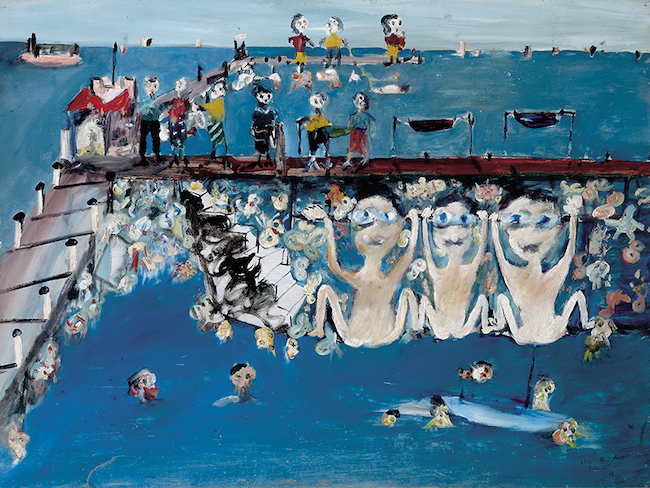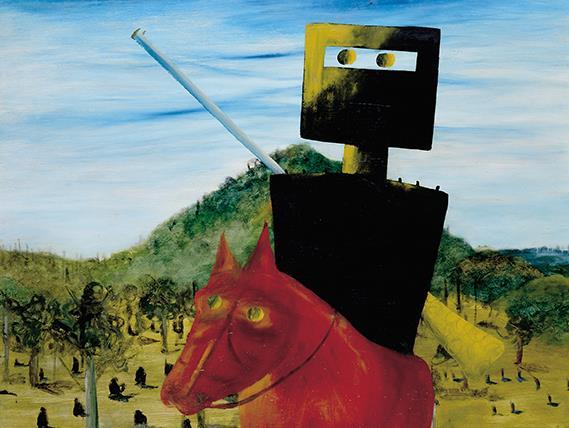Sidney Nolan’s Kelly and horse, 1946 Foundation Collection, Courtesy CMAG
You would be forgiven for thinking that the Canberra Museum and Gallery (CMAG) might not have much to tell you about the Australian story. But CMAG has so much more than an insight into Canberra and its history.
Three current exhibitions feature a focus on design ranging from the history of plastic cameras to the striking mid-century interiors of Marion Hall Best. The third, and uniquely Canberra story, is Total Design, which features the work of the Australian National University Design Unit, the small team who from 1953-77, crafted everything on campus from furniture to signage and landscape.
On permanent exhibition, are 24 treasured paintings from one of the nation’s masters. Sidney Nolan pioneered modernism by taking his skewed view on Australian legends like Ned Kelly or Burke and Wills, both of which star in CMAG’s collection. Nolan is best known for the iconic Kelly paintings. Not only are they visually memorable, but the Kelly paintings were deeply innovative at the time.
Senior Curator Virginia Rigney explains what makes these early Nolan works unique: ‘It’s a little known fact that these works were the first works about Kelly that he painted. The second complete series is across the water at the National Gallery, but with these works he was very much experimenting – not only with painted form – in the combination of new acrylic paints with oil and oil wash, but also narrative structures and the sense of connecting his own personal mythologies with that of a well-known historical one.’
Nolan as an emerging artist
When Nolan began work on the first Kelly series, he was very much an emerging artist, still honing his style. He had deserted his post with the army out in the Wimmera in 1944 and lived for a time under an assumed name. He was already interested in Ned Kelly as a larikn antihero and visited Glenrowan – the site of Kelly’s last stand and capture – with his friend the writer Max Harris in search of a direct encounter with the whole story.
Nolan’s apparently simple style owed more to his background in advertising that to any art school training.
As Rigney observed, the five years he spent working in the advertising department of Fayrefield Hats influenced his style enormously: ‘In the fast-paced workplace, he absorbed new techniques of modern advertising, and – having access to the latest European and American fashion and advertising magazines – he could see how combinations of photographic imagery worked with illustration. So he was also able to cut up and collage these magazines for himself and use modern spray paints and enamel.’
Equally fascinating for the artist were the so-called primitive artists like Henri Rouseau and surrealist poets and writers.
A visitor might pass over one particular work that is very important: Ned Kelly 1945. As Rigney explained, ‘It was the first time that Nolan used the visual device of the square helmet. Quickly, over the series of eight of these smaller works that we have on display, that helmet becomes simplified to the single eye slit, and the body loses its practical appendages to become a powerful looming presence in the landscape in the seminal work Kelly and Horse from 1946.’
The evolution of this iconic image is fascinating as Nolan grows in confidence as an artist. For Rigney, Nolan is a fascinating painter ‘who described himself as ‘a lurking larrikin on standby’ – curatorially that has to keep you on your toes.’

Sidney Nolan’s Under the Pier 1945, Foundation Collection, Courtesy CMAG
Building his own artistic legacy
Nolan himself felt the need to create this artistic legacy later in his life as part of the Australian cultural revival ushered in by the Whitlam Government.
‘Nolan personally selected key works including drought pictures, Central Australia and the iconic Death of Captain Fraser as well as works from the first Kelly series, and gave them to the people of Australia in 1974’ Rigney said.
Originally the works were on display at Lanyon Homestead until 2003 when ‘the risk of the encroaching bushfires they were transported quickly to the Canberra Museum and Gallery building in the city,’ explained Rigney.
Soon Nolan’s works will be moving to a new home, though still easy to locate at CMAG. Rigney said ‘In July they will be moved upstairs into a newly refurbished gallery space in our building and we are working on a whole range of new interpretative programs to support visitors to engage with the works.
‘The larger space will also enable us to show the many other Nolan works on paper that we have in the collection.’ With the ability to display more works and offer more programs these works will shine.
On permanent display
Entry is free





